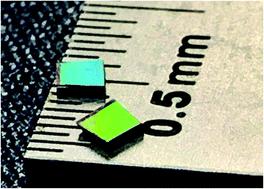当前位置:
X-MOL 学术
›
Faraday Discuss.
›
论文详情
Our official English website, www.x-mol.net, welcomes your
feedback! (Note: you will need to create a separate account there.)
Bio-inspired gas sensing: boosting performance with sensor optimization guided by "machine learning".
Faraday Discussions ( IF 3.3 ) Pub Date : 2020-05-12 , DOI: 10.1039/d0fd00035c R A Potyrailo 1 , J Brewer 1 , B Cheng 1 , M A Carpenter 2 , N Houlihan 2 , A Kolmakov 3
Faraday Discussions ( IF 3.3 ) Pub Date : 2020-05-12 , DOI: 10.1039/d0fd00035c R A Potyrailo 1 , J Brewer 1 , B Cheng 1 , M A Carpenter 2 , N Houlihan 2 , A Kolmakov 3
Affiliation

|
The performance of existing gas sensors often degrades in field conditions because of the loss of measurement accuracy in the presence of interferences. Thus, new sensing approaches are required with improved sensor selectivity. We are developing a new generation of gas sensors, known as multivariable sensors, that have several independent responses for multi-gas detection with a single sensor. In this study, we analyze the capabilities of natural and fabricated photonic three-dimensional (3-D) nanostructures as sensors for the detection of different gaseous species, such as vapors and non-condensable gases. We employed bare Morpho butterfly wing scales to control their gas selectivity with different illumination angles. Next, we chemically functionalized Morpho butterfly wing scales with a fluorinated silane to boost the response of these nanostructures to the vapors of interest and to suppress the response to ambient humidity. Further, we followed our previously developed design rules for sensing nanostructures and fabricated bioinspired inorganic 3-D nanostructures to achieve functionality beyond natural Morpho scales. These fabricated nanostructures have embedded catalytically active gold nanoparticles to operate at high temperatures of ≈300 °C for the detection of gases for solid oxide fuel cell (SOFC) applications. Our performance advances in the detection of multiple gaseous species with specific nanostructure designs were achieved by coupling the spectral responses of these nanostructures with machine learning (a.k.a. multivariate analysis, chemometrics) tools. Our newly acquired knowledge from studies of these natural and fabricated inorganic nanostructures coupled with machine learning data analytics allowed us to advance our design rules for sensing nanostructures toward the required gas selectivity for numerous gas monitoring scenarios at room and high temperatures for industrial, environmental, and other applications.
中文翻译:

仿生气体传感:通过“机器学习”指导的传感器优化来提高性能。
现有气体传感器的性能在现场条件下通常会下降,因为存在干扰时测量精度会降低。因此,需要新的传感方法来提高传感器的选择性。我们正在开发新一代气体传感器,称为多变量传感器,它具有多种独立响应,可使用单个传感器进行多种气体检测。在这项研究中,我们分析了天然和人造光子三维(3-D)纳米结构作为传感器检测不同气体种类(例如蒸汽和不凝气体)的能力。我们采用裸露的Morpho蝴蝶翅膀鳞片来控制其在不同照明角度下的气体选择性。接下来,我们用氟化硅烷对Morpho蝴蝶翅膀鳞片进行化学功能化,以增强这些纳米结构对感兴趣的蒸汽的响应,并抑制对环境湿度的响应。此外,我们遵循之前开发的传感纳米结构设计规则,并制造了仿生无机 3D 纳米结构,以实现超越自然Morpho尺度的功能。这些制造的纳米结构嵌入了具有催化活性的金纳米颗粒,可在约 300 °C 的高温下运行,用于固体氧化物燃料电池 (SOFC) 应用中的气体检测。通过将这些纳米结构的光谱响应与机器学习(又名多元分析、化学计量学)工具相结合,我们在检测具有特定纳米结构设计的多种气体物质方面取得了性能进步。我们从这些天然和人造无机纳米结构的研究中新获得的知识,再加上机器学习数据分析,使我们能够改进传感纳米结构的设计规则,以实现工业、环境和工业等领域的室温和高温下多种气体监测场景所需的气体选择性。其他应用程序。
更新日期:2020-05-12
中文翻译:

仿生气体传感:通过“机器学习”指导的传感器优化来提高性能。
现有气体传感器的性能在现场条件下通常会下降,因为存在干扰时测量精度会降低。因此,需要新的传感方法来提高传感器的选择性。我们正在开发新一代气体传感器,称为多变量传感器,它具有多种独立响应,可使用单个传感器进行多种气体检测。在这项研究中,我们分析了天然和人造光子三维(3-D)纳米结构作为传感器检测不同气体种类(例如蒸汽和不凝气体)的能力。我们采用裸露的Morpho蝴蝶翅膀鳞片来控制其在不同照明角度下的气体选择性。接下来,我们用氟化硅烷对Morpho蝴蝶翅膀鳞片进行化学功能化,以增强这些纳米结构对感兴趣的蒸汽的响应,并抑制对环境湿度的响应。此外,我们遵循之前开发的传感纳米结构设计规则,并制造了仿生无机 3D 纳米结构,以实现超越自然Morpho尺度的功能。这些制造的纳米结构嵌入了具有催化活性的金纳米颗粒,可在约 300 °C 的高温下运行,用于固体氧化物燃料电池 (SOFC) 应用中的气体检测。通过将这些纳米结构的光谱响应与机器学习(又名多元分析、化学计量学)工具相结合,我们在检测具有特定纳米结构设计的多种气体物质方面取得了性能进步。我们从这些天然和人造无机纳米结构的研究中新获得的知识,再加上机器学习数据分析,使我们能够改进传感纳米结构的设计规则,以实现工业、环境和工业等领域的室温和高温下多种气体监测场景所需的气体选择性。其他应用程序。











































 京公网安备 11010802027423号
京公网安备 11010802027423号